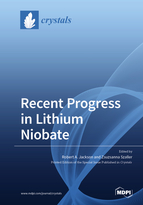Recent Progress in Lithium Niobate
A special issue of Crystals (ISSN 2073-4352). This special issue belongs to the section "Inorganic Crystalline Materials".
Deadline for manuscript submissions: closed (31 March 2020) | Viewed by 33374
Special Issue Editors
Interests: computer modelling; interatomic potentials; optical materials; defects and dopants
Special Issues, Collections and Topics in MDPI journals
Special Issue Information
Dear Colleagues,
This planned special issue of Crystals is the third issue devoted to LiNbO3 (the previous two being on ‘Lithium Niobate Crystals’ and ‘Thin Films and Nanocrystals’).
LiNbO3 is an all-star material from both the scientific and technological viewpoints and the subject of a great number of publications since its first preparation in 1937. Due to its excellent electro/acousto-optical properties, LiNbO3 has been widely used in optoelectronic devices for decades, ranging from optical fibre communications to wireless and micromechanical systems. Among the latest applications are modulators and filters with lasers on a single LiNbO3 wafer, especially promising in integrated optics. Recently, high quality low optical loss source material for waveguides such as lithium niobate on insulator (LNOI) is playing an important role in photonic integrated circuits. LiNbO3 provides powerful optical components in high-energy laser applications, in terahertz technology and is also the subject of lead-free piezoceramics and nanophotonics.
The different applications require different forms of LiNbO3 such as bulk, thin film, nanocrystal and composite. In this Special Issue studies are welcomed dealing with different preparation techniques of different forms of LiNbO3, theoretical and experimental investigations of their structure and research on specific developments and novel applications.
Dr. Robert A. Jackson
Dr. Zsuzsanna Szaller
Guest Editors
Manuscript Submission Information
Manuscripts should be submitted online at www.mdpi.com by registering and logging in to this website. Once you are registered, click here to go to the submission form. Manuscripts can be submitted until the deadline. All submissions that pass pre-check are peer-reviewed. Accepted papers will be published continuously in the journal (as soon as accepted) and will be listed together on the special issue website. Research articles, review articles as well as short communications are invited. For planned papers, a title and short abstract (about 100 words) can be sent to the Editorial Office for announcement on this website.
Submitted manuscripts should not have been published previously, nor be under consideration for publication elsewhere (except conference proceedings papers). All manuscripts are thoroughly refereed through a single-blind peer-review process. A guide for authors and other relevant information for submission of manuscripts is available on the Instructions for Authors page. Crystals is an international peer-reviewed open access monthly journal published by MDPI.
Please visit the Instructions for Authors page before submitting a manuscript. The Article Processing Charge (APC) for publication in this open access journal is 2600 CHF (Swiss Francs). Submitted papers should be well formatted and use good English. Authors may use MDPI's English editing service prior to publication or during author revisions.
Keywords
- Crystal growth
- Crystal defects
- Computer modelling
- Nanocrystals and nanopowders
- Thin films
- Composites
- Lithium niobate waveguides
- Integrated optics
- Nonlinear optics
- Photonics
- Photovoltaics
- THz-wave generation







